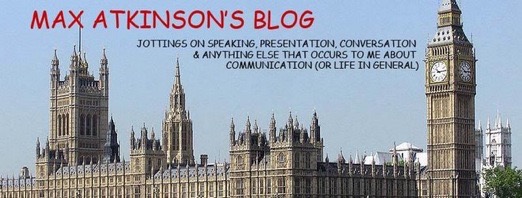
This is the first in a series of three posts on one particularly destructive part of its legacy of collateral damage to our ability to communicate with each other.
When new universities were being built during the 1960s, there were arguments at some of them about whether to install blackboards or whiteboards in the lecture theatres. The pro-blackboard lobby opposed change because, they claimed, it would spell the end of tax relief for damage to clothes from chalk dust. Advocates of white boards thought them trendy, modern and more in keeping with the architecture of the new universities.
But one thing that was never questioned by either side was that writing or drawing on boards, whether black or white, was an indispensable part of the presentational process.
Today, the debate would be about what kind of computer and projection systems should be installed, and what would never be questioned would be the effectiveness of PowerPoint presentations – even though there remain serious questions about whether this dramatic technological shift in the way visual aids are used was a change for the better.
Like a 20th century Pandora’s box, the computer, aided and abetted by Microsoft, has unleashed new and previously unheard of maladies on millions of unwary victims. Chronic slide-dependency has reached pandemic proportions, its main symptoms being a compulsive urge by speakers to put up one boring slide after another, and an inability to say anything without reading from prompts on the screen. It has inhibited the ability of presenters to convey enthusiasm for their subjects and infects those on the receiving end with confusion and self-doubt as they slip quietly into a coma, blaming themselves for their inability to absorb so much information in so short a space of time.
Ask people how they like listening to the modern slide-driven style of delivery, and you’ll soon discover a deep groundswell of dissatisfaction. Go a step further and ask how they rate the slide-dependent majority as compared with the eccentric And tiny minority who still use chalk and talk, and the verdict invariably comes down against the new orthodoxy.
As for how a style of speaking that audiences don’t much like became the norm I’ve discussed in more detail elsewhere (along with the relative merits of other types of visual aid). Part of the story is that it probably all come about because of a terrible accident.
AN UNEXPECTED RESULT OF TECHNOLOGICAL INNOVATION
Slide-dependency can be seen as the legacy of a change in the way the overhead projector – PowerPoint’s immediate ancestor – was originally intended to be used. The invention of the OHP, if anyone can remember that far back, was designed to overcome a problem with using chalk and talk when speaking to large audiences, namely that people couldn’t see what was being put on the board from a long distance away. So the original natural habitat of the OHP was the large auditorium, where speakers used them in much the same way as they’d used blackboards, writing on a roll of acetate and winding it forward whenever they ran out of space.
Then came what must surely be the darkest day in the history of the modern presentation: the arrival of a new breed of photocopiers in the 1970s that was no longer limited to copying on to paper, but could print directly on to sheets of acetate. What seemed rather a small technological step turned out to be a giant leap into completely new way of presenting. More and more speakers stopped writing and drawing as they went along and started using pre-prepared slides made up of lists that were, in effect, their notes.
This new style of delivery not only survived the replacement of OHPs by computerised graphics, but was also implicitly encouraged by assumptions built into programs like PowerPoint.
Most of the initial templates it offers to users are for producing lists of bullet points. What’s more, a fairly recent version came equipped with the added bonus of a set of 23 ‘model’ presentations to make your life easier. They were made up of 214 slides, 94% of which – yes, more than nine out of ten of them – consisted entirely of written words and sentences.
In the light of this, there’s something very strange to hear a Microsoft executive announcing that one of the best PowerPoint presentations he ever heard had no slides with bullet points on them, or when Bill Gates himself didn’t use them in his TED presenation.
Perhaps the most extraordinary thing of all about the PowerPoint revolution was that no one seemed to notice what was happening, let alone stop and ask whether anything important was being lost by the sudden death of chalk and talk.
But, having continued to advocate the effectiveness of using blackboards, whiteboards and flipcharts, I can report that none of my pupils who has tried it out has ever regretted it, and most say that they achieved better rapport with their audiences than they had ever experienced when using slides. This, together with other evidence accumulated over the past twenty years, has convinced me that a wider discussion of its forgotten benefits is long overdue.
(To be continued in Part 2: 'The lost art').
PREVIOUS POSTS ON POWERPOINT INCLUDE:
• PowerPoint program on BBC Radio 4
• BBC Television News slideshow quiz
• How NOT to use PowerPoint
• If Bill Gates doesn’t read bullet points from PowerPoint slides …
• An imaginative innovation in a PowerPoint presentation
• PowerPoint presentation continues to dominate BBC News – courtesy Robert Peston (again)
• Slidomania contaminates another BBC channel
• There’s nothing wrong with PowerPoint – until there’s an audience
• BBC Television News: produced by of for morons?
• PowerPoint comes to church


